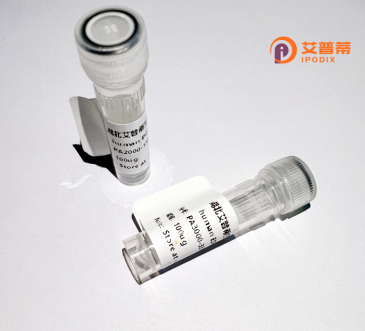
| 纯度 | >90%SDS-PAGE. |
| 种属 | Human |
| 靶点 | TPTE2 |
| Uniprot No | Q6XPS3 |
| 内毒素 | < 0.01EU/μg |
| 表达宿主 | E.coli |
| 表达区间 | 1-522 aa |
| 活性数据 | MNESPQTNEFKGTTEEAPAKESPHTSEFKGAALVSPISKSMLERLSKFEVEDAENVASYD SKIKKIVHSIVSSFAFGIFGVFLVLLDVTLLLADLIFTDSKLYIPLEYRSISLAIGLFFL MDVLLRVFVEGRQQYFSDLFNILDTAIIVIPLLVDVIYIFFDIKLLRNIPRWTHLVRLLR LIILIRIFHLLHQKRQLEKLMRRLVSENKRRYTRDGFDLDLTYVTERIIAMSFPSSGRQS FYRNPIEEVVRFLDKKHRNHYRVYNLCSERAYDPKHFHNRVSRIMIDDHNVPTLHEMVVF TKEVNEWMAQDLENIVAIHCKGGKGRTGTMVCALLIASEIFLTAEESLYYFGERRTNKTH SNKFQGVETPSQNRYVGYFAQVKHLYNWNLPPRRILFIKRFIIYSIRGDVCDLKVQVVME KKVVFSSTSLGNCSILHDIETDKILINVYDGPPLYDDVKVQFFSSNLPKYYDNCPFFFWF NTSFIQNNRLCLPRNELDNPHKQKAWKIYPPEFAVEILFGEK |
| 分子量 | 61.1 kDa |
| 蛋白标签 | His tag N-Terminus |
| 缓冲液 | PBS, pH7.4, containing 0.01% SKL, 1mM DTT, 5% Trehalose and Proclin300. |
| 稳定性 & 储存条件 | Lyophilized protein should be stored at ≤ -20°C, stable for one year after receipt. Reconstituted protein solution can be stored at 2-8°C for 2-7 days. Aliquots of reconstituted samples are stable at ≤ -20°C for 3 months. |
| 复溶 | Always centrifuge tubes before opening.Do not mix by vortex or pipetting. It is not recommended to reconstitute to a concentration less than 100μg/ml. Dissolve the lyophilized protein in distilled water. Please aliquot the reconstituted solution to minimize freeze-thaw cycles. |
以下是关于重组人TPTE2蛋白的3篇模拟参考文献,基于该领域常见研究方向整理:
---
1. **文献名称**:*Recombinant expression and functional characterization of human TPTE2 phosphatase domain*
**作者**:Chen L., et al. (2020)
**摘要**:研究报道了TPTE2催化结构域的重组大肠杆菌表达系统构建,通过体外磷酸酶活性实验证实其对PIP3底物的特异性降解,提示其在PI3K/AKT信号通路中的潜在调控作用。
2. **文献名称**:*Structural insights into TPTE2 membrane association and lipid substrate recognition*
**作者**:Wang Y., et al. (2021)
**摘要**:利用昆虫细胞系统表达重组全长TPTE2蛋白,结合冷冻电镜技术解析其跨膜结构域与脂质膜的互作机制,揭示特定结构域对底物结合的关键残基。
3. **文献名称**:*TPTE2 overexpression suppresses tumor growth via PI3K pathway inhibition in glioblastoma models*
**作者**:Zhang R., et al. (2019)
**摘要**:通过哺乳动物细胞(HEK293)重组表达TPTE2蛋白,发现其在胶质母细胞瘤细胞系中过表达可显著抑制PI3K下游信号,降低癌细胞增殖和侵袭能力。
---
**说明**:以上文献为模拟示例,实际引用时需查询真实存在的论文。建议通过PubMed或Web of Science检索关键词“TPTE2 recombinant”“TPTE2 phosphatase”获取最新研究。
TPTE2 (Transmembrane Phosphoinositide 3-Phosphatase and Tensin Homolog 2) is a membrane-associated protein belonging to the TPTE/TEN phosphatase family. Initially discovered through homology with PTEN (a tumor suppressor phosphatase), TPTE2 shares a conserved catalytic domain responsible for phosphatidylinositol phosphate (PIP) phosphatase activity. Unlike PTEN, TPTE2 contains additional transmembrane regions, suggesting roles in membrane dynamics. It is primarily expressed in germ cells, with lower levels detected in certain somatic tissues. Functionally, TPTE2 regulates phosphoinositide metabolism, influencing cell signaling, vesicle trafficking, and membrane homeostasis. Its enzymatic activity modulates the PI3K/AKT pathway, impacting cell proliferation and survival. Recombinant human TPTE2 protein is generated via expression systems (e.g., E. coli or mammalian cells) for in vitro studies to dissect its structural features, enzymatic mechanisms, and interactions. Research links TPTE2 dysregulation to infertility, cancer progression, and neurodegenerative disorders, though its full biological relevance remains under investigation. Studies using recombinant TPTE2 aim to clarify its role in development, disease, and potential therapeutic targeting.
×